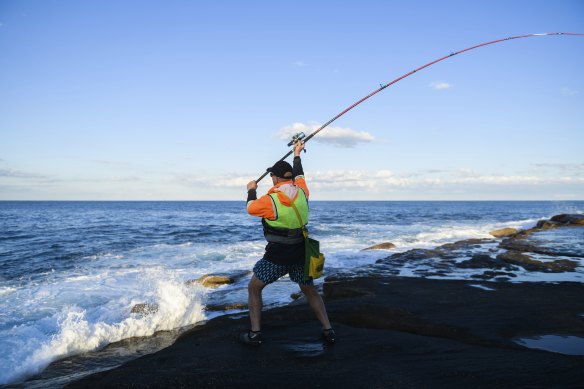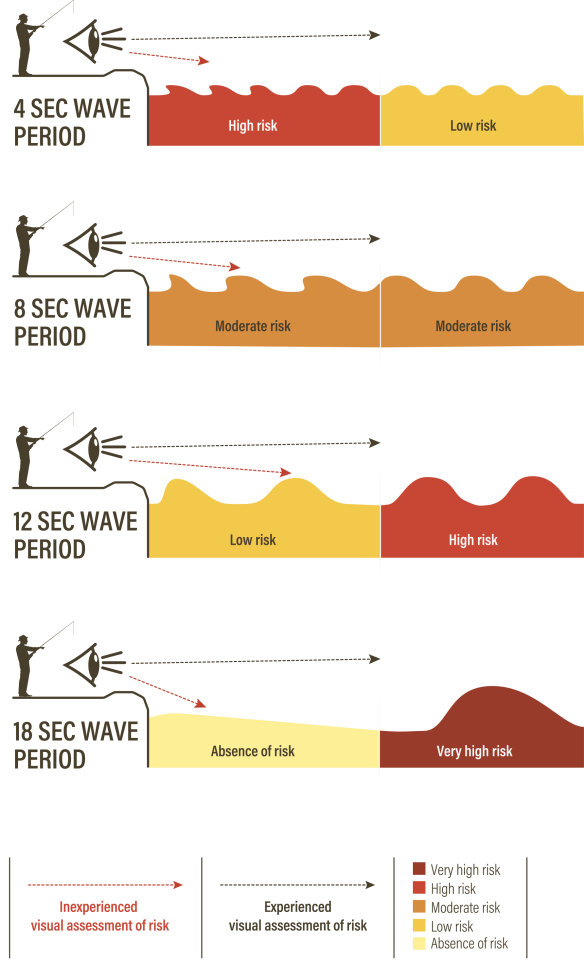The popular seaside pastime that is one of Australia’s most deadly hobbies
By Julie Power
Rock fishing guide Alex Bellissimo bounds like a goat up the hill from the beach to retrieve his fishing hat from his car.
Back on the wet rocks at Freshwater, on Sydney’s northern beaches, though, he is all caution.
When Bellissimo is asked how many times he has been washed off the rocks in 40 years of rock fishing, he is indignant. “Never,” he says. He is disgusted that some fishers boast of how often they have been washed in.

Rock fisherman Alex Bellissimo has been rockfishing, and teaching it for decades. He has seen or been involved in the rescue of 13 people. Credit: Rhett Wyman
Rock fishing is one of Australia’s most dangerous pastimes, causing 241 drowning deaths from 2004 to 2024.
Police fear the worst after a father and his 17-year-old son went missing from the Kiama blowhole, on the NSW South Coast, last week. The search was suspended on Thursday.
Two-thirds of Australia’s rock fishing deaths are in NSW, according to figures from Surf Life Saving Australia. The most deadly local government areas (LGAs) are Randwick, where 24 people including two men at Little Bay in July have died since 2001, and the Northern Beaches, where 22 have died since 2004.
Who goes fishing?
About a million Australians go fishing every year on the rocks, in rivers, by boat and from the beach.
Most fishers who die in Sydney travel more than 50 kilometres from their homes to the coast, prompting Randwick City Council to ask councils across the state to support its Make a Safe Choice campaign.
Nearly all of these deaths are men, and two-thirds were born in Asia. Randwick wants councils with large non-English-speaking populations to disseminate the campaign’s newly updated safety materials in Vietnamese, Korean and Chinese.
Bellissimo takes it further, saying it should be compulsory for foreign language newspapers in Sydney to run safety warnings.
How does an experienced fisher avert disaster?
The deadliest time to fish often looks the calmest.
University of Melbourne and Surf Life Saving Australia research has found there were more rock fishing deaths when the period between waves was longer than when waves came quickly. This calm lulled inexperienced fishers into a false sense of security.
University of Melbourne researcher Peter Kamstra said: “Many fishers believe improving the ways we communicate the risk of long-period waves – not freak waves – to inexperienced fishers is the best way to save lives.”
The increased time between waves can give the sea a safer, calmer look, causing less experienced fishers to be unprepared for large overlapping waves and panic, running to safety on slippery rocks.
On the day we talk to Bellissimo, there’s a 1.8-metre swell near a spot infamous for a series of rock fishing deaths in the 1980s.
Before he does anything, he watches the sea, getting a sense of the timing and power of the waves. He recommends anglers monitor small wave period (lulls) and large wave periods (also called sets) for about three to four cycles.
Tips from Alex Bellissimo and others for safer fishing
- Don’t fish alone
- Never turn your back on the sea
- Keep your eyes in the direction of the waves and the rod
- Don’t cast before you understand the size and timing of a set of waves, including the lull
- Wear a lifejacket, wear shoes with steel spikes to increase grip and avoid clothes that sink, such as jeans
- Know the tides
- Look where you are walking
- Don’t drink. Bellissimo refuses to take fishers who drink alcohol because it encourages risk-taking
- Pack your gear away where it won’t get washed away
- Know your location and give it in this order: NSW, Freshwater, off the rocks near McKillop Park Reserve
- Know the number for emergencies and bring your phone fully charged, or carry a spare
Bellissimo wears fishing shoes with steel spikes to reduce the chance of slipping, a life jacket, and lightweight board shorts that won’t weigh him down if he is washed off. His gaze is firmly out to sea when he finally casts – not on his rod tip or the waves near the shore.
Asked what inexperienced and beginner rock fishers are thinking when they put their lives at risk by fishing without a life jacket, or standing in a dangerous spot, he says, “Nothing, nil, zero. That’s the problem.”
Why don’t more fishers wear life jackets?
Surf Life Saving Australia national research manager Dr Jaz Lawes says rock fishing deaths appear to be declining since wearing a life jacket became compulsory in 2016. But enforcement is challenging, she says: at least 75 per cent of those who had fatally drowned since 2004 were not wearing one.
Many fishers say they don’t need life jackets because they can float for 10 minutes, the time they think it takes to get rescued.
“We have to remind them, ‘Can you still float for 10 minutes after you have hit your head?’” Lawes says. “Can you float for 30 minutes?”
Or: can they float in their clothes? Many bodies have been recovered with waders filled with water.
How long can it take to get rescued?
With decades of experience, Bellissimo has witnessed the deaths of more than 13 rock fishers. “Too many to count,” he says.
Some slipped and fell off the rocks. Others had heart attacks, like Donald White, a 71-year-old rock fisher whose 2012 death at North Curl Curl formed part of the NSW coronial inquiry which recommended mandatory life jackets.

Experienced and inexperienced rock fishers evaluate risk differently. Less experienced fishers fail to understand that a lull between sets usually precedes bigger, more powerful waves.Credit: Surf LIfe Saving Australia
White wasn’t wearing a life jacket when he fell into the water 80 metres away from where Bellissimo and a videographer were updating a video on rock safety.
Bellissimo called triple zero and threw a life buoy to the videographer. With Bellissimo on the rocks calling for help, the videographer manoeuvred White into the flotation device. A police officer paddled out to help.
It took 55 minutes, says Bellissimo, to get the dead man to shore through the waves.
What can be done?
Randwick’s safety campaign is deliberately shocking, featuring 24 red skulls representing each of those who have died.
“For more experienced fishers, making a safe choice might mean picking a different rock ledge on rough days or being more cautious. But for newcomers to the sport or those who can’t swim, a safe choice means fishing off a beach or from a jetty in the harbour instead,” Randwick Mayor Philipa Veitch says.
A growing body of Australian research suggests that nurturing informal networks where experienced fishers like Bellissimo mentor younger fishers could save lives.
These experienced fishers know so-called “freak waves” are a myth.
NSW Recreational Fishing Alliance president Stan Konstantaras agreed the government needed to bring experienced rock fishers together with multicultural groups to teach skills and safety. “I’ve been on the rocks all my life and nobody ever asked me for advice, or called me,” he said.
Start the day with a summary of the day’s most important and interesting stories, analysis and insights. Sign up for our Morning Edition newsletter.